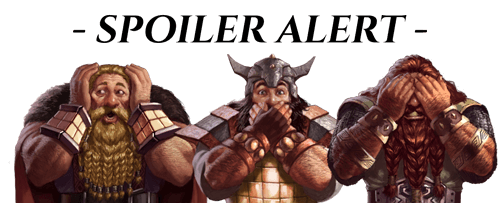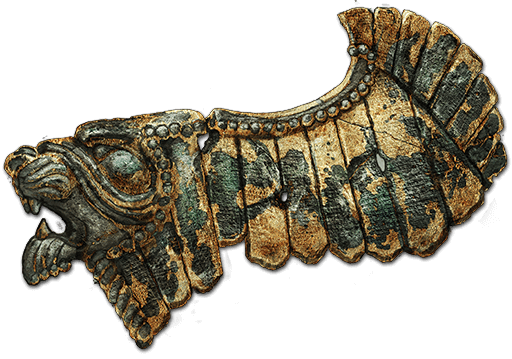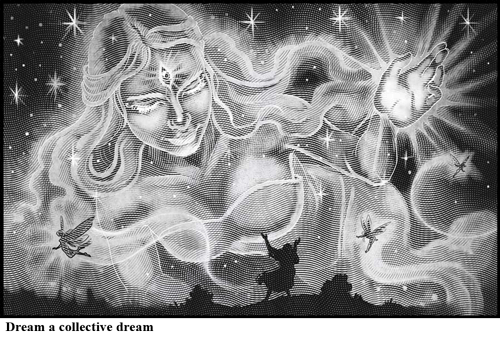
Dietta the Mouse, Augstat, Hesse
This reporting is late due to the sensitivity of those who attended the festival and the mystic nature of the location where the festival was held. –Ed.
Parts of the Garnon Forest were turned gaily upside-down last winter during Dreams week as the forest served as the site for a rambunctious Dream Festival, organized by Esaleen Drearthian, the Great Druid, in conjunction with Rubenstein. The party was scheduled to coincide with a rare magical nexus in the Garnon Forest. Esaleen and Arismarne (Rubenstein full-practitioner), through extensive research of Anumian charts and forest ley line activity, were able to predict the time when magic would be at its wildest, and the Garnon Forest would be alive with mischief and romance.
Rubenstein of Augstat sent hundreds of invitations by Gekkon courier to every kingdom in Chaldea. Invitees consisted of the world’s elite, a who’s who of socialites, nobles, the ultra-wealthy, and the well connected, including a few dragons and a pantheon of demigods and heroes, all of who came out for the special occasion. The exclusive invitations were printed on Anumian fate cards, requiring a seer to decipher “a tax to separate the wheat from the chaff,” said a Rubenstein representative.
For most, the 150+ league journey to the Great Druid’s clearing began in Tartu “under the root.” The distance was covered in less than a few hours guided by woodland sprites and pixies through magical paths.
The three-day all–expenses-paid extravaganza included private lodging for all 1,200 guests and with numerous luxurious amenities within reach at all times.
Costumed guests dressed as gods arrived via golden sun chariots pulled by winged stallions, and each time a new “god” arrived, the crowd burst into wild applause and divine adoration. Attendees paraded past Esaleen, who was on an enormous ziggurat throne, surrounded by a halo of singsong birds whistling as fireworks burst overhead.
The rumored guest list attracted elite celebrities: Emperor Kordaava (shadowed by drasildar sentinels); Ariadne, elven demigoddess and Queen of Latium accompanied by the elven demigod Cerion as her date; Patesi Iltani of Akkadia (Anum demigoddess); Lalfroth (Elder dragon and grand vizier of the empire); high elves Willowalta (White Mage) and Ventiss (Warden of the Forested Lands of the Empire); Senator Xune (Imperial Consul); and socialites like Senator Sibyl Serrari, Janek Tihomir, and Lian Kordaava, daughter of the emperor. In fact, the guest list was so prestigious, that Tarsis, the Imperial Consul of the Military, joked, “If the Garnon swallowed this clearing this instant, the empire would cease to function.”
Guests had an assortment of lavish and surreal activities at their disposal. Fairies darted about, causing mischief and mayhem, painting outrageous caricatures, shooting guests with love arrows, offering prank cocktails and aphrodisiacs, and spraying pixie dust while waitstaff served elaborate concoctions of exotic herbs, spices, and liquors, some potent enough to kill an elder dragon. Constant entertainment was aplenty, featuring Ardayan musicians and belly dancers, ballerinas, and crash couches staffed with masseuses. Music included orchestras, burlesque dancers, and boisterous dwarven singing. Other entertainment spotlighted drag king and queens, cabaret, and games of chance. Guests were treated to theatrical performances from Dorsang bards reciting selections from Dorian comedies and tales from Ragnarok; and everywhere were a parade of fools and tomfoolery. King of the fools was a manic jester dressed in checkered harlequin and a mask of many emotions, who danced and cavorted, mingling with partygoers and offering free Anumian fate card readings.
The parade grounds were cordoned off into individually themed glades with high pavilions, each “hosted” by a different divine pantheon: Greek wine poured endlessly from Olympus as actors reenacted famous tragedies; Norse ale was served in giant authentic handcrafted horns with giant boars roasting over spits; Ma’at sun barges floated with guests on a lazy river around a sun-dappled pyramid. Arching high over the clearing—over the pantheon pavilions and expansive manicured gardens—were wide-sweeping canopies of orchids and lotus. Below was a dreamland festival with succulent treats to entice the senses, tables laden with food and drink from all over the empire.
There are rumors circulating that fey magicians called Party Accelerators waved wands in the guests’ faces, cried, “Once upon a dream,” and sprinkled them with fairy dust. After that, many said, the world became a blur.
A graver from Perrin going by the name Horseshoe Jack, dressed as the god Cupid by wearing nothing but a loincloth with mini-white wings, chased the ladies with notched arrow in bow, screaming raunchy poetry such as “When Cupid strikes, genitals ignite” and “My penis, though teeny weeny, tastes savory and dreamy, believe me.”
As one might expect in the Great Druids’ home, woodland flora and fauna erupted with joyous good cheer, friendly and in high spirits. Plants and animals are said to have frolicked, playing games and orchestrated practical jokes freely. Even the emperor was not exempt from becoming an object of the playful creatures’ mischief; several guests claimed to have seen Emperor Kordaava and Lady Sibyl Serrari running through the forest naked, though in actuality, Kordaava was in a Norse tavern at the time, leg-wrestling a graver named Fortress Defender, and the lady Serrari was never far from the Olympian spas.
One of the more entertaining moments was said to be when Janek Tihomir, one of Saratof’s most eligible bachelors, spent an entire day naked and became the subject of many jokes. It seems he believed he was dressed as the Olympian hero Achilles when, in fact, a leprechaun had cast an illusion on him.
The dream festival culminated with Arismarne summoning the Anumian spirit Dreamer. Snowflakes accompanied the winter Manifestation of Dreams, each flake unique, each representing a universe of possible dreams. Eyelids grew heavy and fell, and the guests drifted off, fast asleep.
Later, guests reported how rested and relaxed they felt leaving the party, though the three days had become a hazy memory for most, described by some as being akin to one’s dream moments immediately after waking. This is likely the primary reason why our newspaper reporters experienced difficulty obtaining facts and first-hand eyewitness accounts of the event.


Dietta the Mouse, Augstat, Hesse
A rare sight of Tavjan lions soaring over Augstat astonished onlookers midday Tuesday, sending many running for cover.
At the first frightened cry of “Lion!” with fingers pointed skyward, people flooded into the streets to marvel at the fifty lions flying in multiple v-formations not more than a few hundred feet above the tallest tower. The beasts were close enough for observers to see their riders bearing Norse shield and spear.
In response to the spectators below, the lions let forth a wave of mighty roars, each answering the call of the others, until all fifty disappeared over the south wall.
No treaty (formal or otherwise) exists between the bordering kingdoms of Hesse and Tavja that grants the lions and their Norse warriors permission to violate Hessen air.
“F–k, no,” shouted the duty officer, clearly weary of the barrage of questions. “Breaching our borders on foot or on wings is equal and the same. A breach is a breach and should be considered an act of war.”
The lions were only briefly visible flying south out of the Garnon Forest, dipping low along the coast, rising momentarily over the city and then on to who-knows-where.
The Hecks were quickly mobilized, the Round Tower a beehive of kinetic activity, but before even the first knight mounted his charger, the lions were long gone.
If Enchantments Guard provided authorization for the fly-over, they did not share this information with Hesse authorities. Inquiries sent to the 10th Legion resulted in silence, and if they were concerned, they were neither confirming nor denying. Just the same, Hecks doubled up at gates and towers about the city, their eyes turned skyward. Speculation that the lions will return over Augstat weighs equally with the certainty that they will take a different route home.
After Hessens recovered from the brief scare, most agreed that what they witnessed were “magnificent creatures.”


Hasala of Stahleck, Augstat, Hesse
Ever since a graver rose to prominence and became emperor of the world, the graver lifestyle has become more and more enticing and popular. Not an Anumian goes by that we don’t hear strange rumors of gravers raiding lost tombs or risking life and limb fighting unnatural horrors and terrible beasties spat from Hel. Brothers, sisters, humans, elves and dwarves, halflings and gnomes, all species and creeds assembled in a common love of fortune and fame, adventurous souls all.
“Nothing forges relationships faster and tighter than facing death with the lads,” said Fogartaig, a lanky redheaded fellow with a thick Dorian accent, who was having a dent removed from his armor at the Gravers Guild in Guildhaus.
The question most people can’t quite comprehend is why. Is it for the thrill? For discovery? Testing one’s mettle against the wild unknown? Ask a thousand questions, receive a thousand different answers. One thing remains certain: not a tepid soul exists among them, these rule breakers and dealmakers who seek answers to life’s riddles and the mysteries of the universe one adventure at a time.
Welcome to “Graver Lifestyles,” an ongoing column where we jump into the thick of the action, facing death and dismemberment so you don’t have to.


In our first graver exposé, we need travel no farther than our northern border. On Hessenfar Mount, on the edge of the Garnon Forest, sits Braunfel Estates, a three-hundred-year-old winery.
Once one of the largest wine producers in Niessia, the Braunfel family enjoyed singular success and prosperity, their label prized by all who enjoyed robust red varietals.
Driven to build upon their wine empire, they took unnatural steps to influence production output by adding “Garnon scents and flavors” to their inventory. The Braunfels clear-cut sections of the forest to increase the size of their vineyards, allowing the vines’ roots to drink deeply from the Garnon’s rich loam. The venture worked, at least in part, and for a short time, wine production spiked. But the forest soon retaliated; trees and underbrush grew back in leaps and bounds until the estates of Braunfel were buried under an unnatural bramble of vegetation so thick, the Braunfels were forced to abandon their home and business, the loss eventually driving them into ruin.
One person’s vinegar is another person’s wine, they say, so soon, industrious gravers claimed the derelict estates (which neighboring farms avoided, giving it “haunted status”) and turned it into a thriving inn hideaway, open to all who required rest, food, and lodging. Its Great Room, with a river rock hearth and wide oaken beams, enjoys a flurry of daily activity with the comings and goings of gravers, pilgrims, business folk, and hedge knights.
“The key is to live in harmony with the Garnon and treasure it. If you respect it, it will respect you in return,” said Harriet the innkeeper.
The Garnon Forest is widely considered Chaldea’s greatest unexplored treasure, due to its enchanted “mystic” qualities. Those self-same mystic qualities that destroyed the Braunfel winery are what attract gravers to its borders now to test their luck exploring the regions rugged, natural beauty and its deeper, paranormal, multi-canopied environs. The inn enjoys a resurgence in popularity these days, as it has its own set of flavorful customs and traditions driven by a new generation of graver. Each evening, gravers and intrigued clientele enjoy a lazy drink and a smoke. With their bellies sated by a homecooked meal, they huddle around the great hearth to swap tales of derring-do and high adventure, sometimes with great bravado and bombast and at other times with reverent haunted whispers.

Lizardfolk Warbands Terrorize Countryside
The history of Hesse, Tavja, and Andalus is rich with accounts of creatures from the Garnon Forest seeking violent diversions beyond the woods. And rumors suggest it is happening again. Lizardfolk warbands have allegedly raided three villages on the Gelbe Grasflachen, going so far as to mount an attack on the Andalus countryside and forcing local peasants and military to retreat into the fortified town of Mursiya. If the lizardfolk have conducted raids into Tavja, however, the Tavjans haven’t taken action or divulged any details. As if fears of rampaging lizardfolk weren’t enough, recent reports out of Stolhoffen describe fires burning over Gloggu Goor, illuminating the great fortress of Niesse, which was once thought dead, fueling speculation of a possible threatening orc buildup inside. Further, increased sightings of gnoll and goblin activity around the Greymory Wastes has the Hessen military worried. At this time, it isn’t clear who will take responsibility for dealing with these threats, local militia or Imperial legions.


K.I. Issue #107 contains potential spoiler material.
DO NOT READ
until after viewing…


Issue #107






